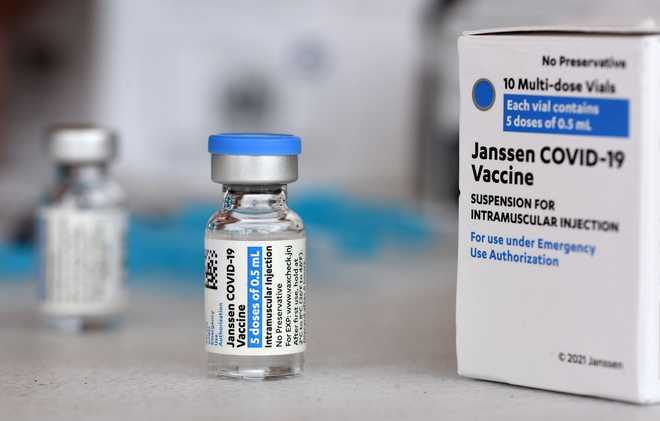Why is the Johnson & Johnson Vaccine paused?
As of April 12, 2021, approximately 6.85 million doses of the Johnson & Johnson (J&J) COVID-19 vaccine (Janssen) have been administered in the United States. The Centers for Disease Control and Prevention (CDC) and the U.S. Food and Drug Administration (FDA) are reviewing data involving six U.S. cases of a rare type of blood clot in individuals after receiving the J&J COVID-19 vaccine that were reported to the Vaccine Adverse Events Reporting System (VAERS).
CDC has provided initial data about this rare type of blood clot and the six women who developed the clot in its April 13 Health Alert Network (HAN) message, and we are awaiting further presentation of data. The blood clot was seen in combination with low levels of blood platelets. All six cases occurred in women between the ages of 18-49 and between 6-13 days after vaccination with J&J vaccine.
This condition is treatable, but doctors must know how to recognize it, how to report it, and how to treat it. This pause is the right thing to do to ensure that happens. There are safety systems in place to flag that work.
Why is Johnson & Johnson vaccine paused?
Today, April 13, 2021, Governor Mike DeWine, Ohio Department of Health Director Stephanie McCloud, and Ohio Department of Health Chief Medical Officer Bruce Vanderhoff, M.D., are advising all Ohio COVID-19 vaccine providers to temporarily pause using the Johnson & Johnson (Janssen) vaccine.
This is in response to a statement by the U.S. Food and Drug Administration (FDA) and the Centers for Disease Control and Prevention (CDC) recommending a pause in the use of the Johnson & Johnson vaccine following rare blood-clotting events in six people in the U.S. after receiving the vaccine. The federal government is expected to pause administration of the vaccine at all federally-run vaccination sites.
Why are the CDC and FDA recommending this pause of the Johnson & Johnson vaccine?
CDC and FDA have recommended a pause in the use of the Johnson & Johnson (Janssen) COVID-19 vaccine in the United States out of an abundance of caution, effective Tuesday, April 13. Of the 6.8 million Janssen COVID-19 vaccine doses administered in the United States to date, six cases of a type of blood clot called “cerebral venous sinus thrombosis” (CVST) were seen in combination with low levels of blood platelets (thrombocytopenia).
How long will this “pause” of the Johnson & Johnson vaccine last?
The CDC will convene a meeting of the Advisory Committee on Immunization Practices (ACIP) on Wednesday, April 14, to further review these cases. The FDA will continue to investigate the cases, and more guidance will be forthcoming.
If I’m scheduled to receive the Johnson & Johnson vaccine, what should I do?
If you are scheduled to receive the Johnson & Johnson vaccine, please contact your healthcare provider, vaccination location, or clinic to schedule another appointment for a Pfizer or Moderna vaccine.
If I’ve received the Johnson & Johnson vaccine, what symptoms should I look for?
If you received the J&J vaccine more than a month ago, the risk is very low at this time. If you develop a severe headache, abdominal pain, leg pain, or shortness of breath within three weeks after vaccination, contact your healthcare provider, or go to the emergency room or urgent care. Let your healthcare providers know that you recently received the Johnson & Johnson vaccine.
Vaccine adverse events are reported through the Vaccine Adverse Event Reporting System (VAERS). VAERS, managed by the CDC and FDA, is part of the larger vaccine safety system in the United States that helps make sure vaccines are safe. A report to VAERS does not mean that a vaccine caused an adverse event. But VAERS can give CDC and FDA important information. FDA and CDC will investigate further and take action as needed.
With this information coming out on the Johnson & Johnson vaccine, should I be concerned about Moderna and Pfizer vaccine?
No impact on the Moderna or Pfizer vaccines.
The Moderna and Pfizer vaccines use a different vaccine technology than the Johnson & Johnson vaccine. There have been no safety concerns with these COVID-19 messenger RNA (mRNA) vaccines.
If you are currently scheduled to receive the Pfizer or Moderna vaccines, we encourage you to keep your appointments and move forward with vaccination.
From the White House COVID-19 Response Team:
- Notwithstanding the current situation, we should have enough vaccine supply to meet the demand for all adults by end of May.
- This incident should not impact the current plan for opening up eligibility for all adults.
- At present, Johnson & Johnson only makes up 5% of the vaccine supply.
- This week, a total of 28 million doses of Pfizer and Moderna will be made available (up from last week), which includes 17.75 million doses to the states, tribes, and territories.

